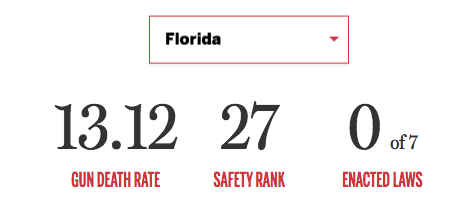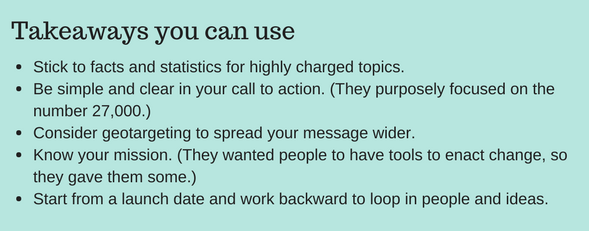Ahead of Saturday’s March for Our Lives, the Boston Globe published an ambitious interactive editorial that shows how many lives a year would be saved — 27,000 — if the rest of the nation had Massachusetts’ rate of gun deaths. The editorial also allows readers to check, state by state, what their state’s toll would be.
There are also proposed solutions, seven of them. The package follows the Globe’s eye-opening editorials in 2016 on gun control, entitled Make It Stop.
The Globe’s deputy Ideas editor, Alex Kingsbury, and Heather Ciras, the senior editor for audience engagement, answered our questions about the effort.
How long was this in the making?
Kingsbury: We’ve been spitballing ideas for an editorial follow-up to the Make It Stop since the day that launched. Make it Stop focused on an assault weapons ban, since those weapons make mass killings more deadly. But the gun story is much, much bigger than mass killings and we wanted to tackle it in an similarly engaging way with calls to action.
Mass shootings make for obvious news pegs. But the undercovered story of gun violence is the daily toll of suicides that go largely unreported even as they vastly outnumber deaths in mass killings. Practically, this project came together in a few weeks, based on some ideas that had been on the back burner and some new faces with fresh thinking.
How did you ensure that no “we're-better-than-you” attitude crept in? Another way of putting it: How did you maintain the "just-the-facts" tone?
Kingsbury: Stick to the statistics. For as many guns as the country has, there’s still a critical role for newspapers to play educating readers about the basics. Seventy-eight percent of American adults don’t own guns. So, casting these editorials as part educational, part advocacy is an important service and a useful storytelling device. Gun death rates are worth focusing on because most people who don’t follow firearms issues closely probably don’t know how big the differences between the states really are.

One of the central elements to this project was the use of IP addresses. If people access the site from another state, based on their IP address, their state’s gun death rate and their laws are central to the experience. That’s how we tried to localize a national epidemic. The calls to action, similarly, were specific to each state. While Make It Stop was a call for federal legislation, this project takes aim at statehouses where legislation may be more likely. It was also important to insist that there’s more Massachusetts can and should to in this area. This isn’t a “Hey, Beacon Hill, rest on your laurels” editorial.
What sort of early response have you gotten? Are there lawmakers from other states who have reached out?
Kingsbury: The project is now being shared widely on social media, but it’s still early. The idea was to ride the wave of interest around the march this weekend and offer specifics to a movement that’s broadly for gun control but doesn’t always articulate the specific steps we should take.
We’ve received a few phone calls from public officials, and gun control advocates, and more may come in. One of the most meaningful calls, early this morning, was from a teacher in Massachusetts, who said she’s taking the section in to her class today to use it as a teaching tool, and taking it to Saturday’s march. And, of course, there have been trolls. So. Many. Trolls. But that’s what happens any time we write about guns.
Ciras: In the special commenting board we created, we have had a lot of thoughtful articulation of how people think we can decrease gun fatalities. There’s a question prompt, and we moderate the comments, only removing things that are racist, violent, or would be unproductive to the conversation.
What's the big question I missed, and what's that answer?
Kingsbury: One point we tried to emphasize is that facts and statistics can propel the debate over guns in an apolitical, rational way. Broad-based punditry — and there’s a lot of it — won’t contribute to real solutions. No one is calling for a repeal of the Second Amendment. No one is calling for confiscation. Even Justice Antonin Scalia, writing in the benchmark Heller decision, acknowledged that there’s a constitutional argument for some regulation of guns. We have to find a way to live with the guns that are out there. This is one way to do it.
As to process, over the years we’ve learned a lot about how to pull these projects off. It starts with working backwards from the launch/publication date and getting lots of ideas early from all the different folks who have a role to play: Designers, developers, audience engagement editors, the printing press folks, and the writers and editors.
To go to all this effort … you must have been thinking about a sophisticated engagement plan.
Ciras: We really felt that having a robust social plan would be priority number one for the engagement strategy for this editorial. We are a subscription-based site, so reaching the broadest audience possible isn't always what we're going for. But the biggest play for this project was to effect change both inside and outside of our Designated Market Area.
We also didn’t want people to merely read the editorial — we wanted to give them a sense that they could help enact this change. The editorial lays out seven things people can ask of their local legislators, so we provided the tools readers could use to contact their state Senate presidents, state House speakers, and governors with a simple click.

And since the gun laws vary wildly by state, we employed geotargeting to ensure that readers get a customized experience that’s relevant to them. For the call to action section, we target a reader’s location so a reader will see the gun death rate and gun laws from his or her state. This isn't just a flashy feature, but a very practical measure taken to simplify the call to action. We're already seeing people tweeting at their politicians using the tools in the story.
We timed the release for just ahead of the March for Our Lives. Marchers are asking for a decrease in gun-related deaths, and here we are telling them how that can be accomplished, and that it will prevent thousands from dying.
We are promoting the 27,000 number a lot: The lives that could potentially be saved a year if all states had the same gun death rate as Massachusetts. We calculated that number for each state. In other words, how many people in Minnesota could be saved in 2016 if it had the same gun death rate as Massachusetts? (The answer is 240, if you're curious). This makes the social plan macro and micro, so we’re hoping to appeal to people on a national and local level.
We promoted all of this on social media, in particular Twitter and Instagram, where much of this conversation has been happening. This story has the potential to make a big impact in every state.
The companion to this story is a vibrant commenting board, which we created using tools from the Coral Project. We did this for our Spotlight series on race, another hot-button issue that often creates a terrible scene in the comments sections, and had a lot of success getting thoughtful, productive comments.
Thank you both for your time.







